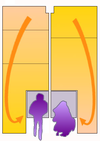Gutter (comic)
Gutter (English for gutter ) is an English technical term and, in Scott McCloud's work, refers to the space between the panels of a comic . McCloud borrows the term from printer's language , which designates the space between two pages (cf. web ), but at the same time uses it metaphorically in connection with the spilled blood of an unseen, i.e. H. Violence "hidden" in the space between two panels, where he speaks of "Blood in the Gutter" . In German, the term is best rendered as "Lücke".
history
Before describing the way in which the gaps between the panels are used, a history of the panel should be provided. In the Middle Ages, for example, two panels were separated from one another by trees or parts of buildings. In the 19th century, when printing was done from wooden sticks, the panels stood next to each other without a frame. Rodolphe Töpfer, who chose a different printing process based directly on the hand drawing, separated the connected panels with a simple line. This simple line separation can still be found in the 20th century, but when panels with a frame, separated by a gap, had become common for the visual language of comics. This method is not always used in newer, experimental comics; Panels are also sometimes integrated into other panels.
layout
The gaps are not perceived as an independent system of lines between the panels, but as a background on which the panels are mounted. Thus, the structure of the gaps results from the size, shape and mounting of the panels on one side. In the case of production line production of comics, the panel borders were sometimes inked by a specially hired assistant before the panel contents were drawn.
construction
The most common are right-angled constructions. A different form has been found in Italy since the middle of the 20th century, from where it influenced the large volumes of Hansrudi Wascher ( Sigurd , Nick ) and also on Propeller Man by Matthias Schultheiss . Here the sides look like broken mirrors:

|
colour
In order to create a strong contrast to the black panel frame and thus a sharp demarcation, the gap is usually white. This results in an optical illusion (black spots) at the crossing points, which can sometimes be disturbing. (See Hermann grid in Optical Illusions ).
A black gap is sometimes used to achieve special effects:
| Example: The page has two different background areas: the upper quarter is white and produces white gaps, the rest is black and therefore produces black gaps. To emphasize the gaps (here two different actions take place at the same time) the horizontal gaps are very narrow. In the right column, the two upper panels are not separated from each other by a gap, but by a speech bubble and the composition lines of the figures. The lower left panel is open in the upper left corner, where it merges seamlessly into the gutter. |

|
Functions
Reading direction
By designing the system of gaps, the reading direction , i.e. the order in which the individual panels are to be viewed, can be made clear.
Horizontal and vertical gaps are usually the same width. Certain reading directions can be emphasized by suitable dimensions of the panels and their assembly:

|

|
| Reading direction along the lines | Reading direction along the columns |
| Emphasis on the lines by doubling the horizontal gap width | Emphasis on the columns: instead of the horizontal gaps there are only narrow black dividing lines. The page represented a complex composition to a parallel plot that takes place in the two columns and ends in the two separate panels. But these are so short that there is a wide gap in which the figures emerge from their panel. (See also graphic storytelling strategies ) |

|

|
Drawing and writing surface
- Sometimes there are explanatory notes in the horizontal gaps. (Example: The German editions of Asterix and Obelix contain the translations of the Latin proverbs.)
- Explanatory text is inserted in heavily widened gaps.
|
|
- In the gap, graphic elements are continued that, as it were, break the frame of the panel.
- There are independent graphic elements in the gap.
swell
- ↑ Matthiass Schultheiss: Propeller-Mann. Volume 1, pages 14 and 15, Hummelcomic 1994
- ↑ Example from Derib , Jo , page 41; Fondation pour la Vie, 1991
- ↑ Milo Manara , Hugo Pratt : An Indian Summer. Volume 1 and 2nd Edition Comic Art published by Carlsen Verlag, 1986
- ↑ Example from Derib, Jo, page 28; Fondation pour la Vie, 1991